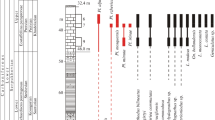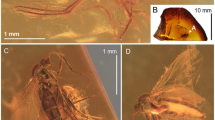Abstract
The status, scope and classification of the sublithistid demosponge genus Petromica Topsent are revised through morphological analysis of museum specimens of all seven species (including proposed synonyms and varieties), two of which were collected and observed in situ along the Brazilian coast (P. ciocalyptoides (Van Soest & Zea) and P. citrina sp. n.). The synonymy of Petromica and Monanthus Kirkpatrick with priority to the former is justified due to the consistent presence of monocrepid rhizoclone desmas and oxeas in an halichondroid arrangement, and to the lack of co-variance in other morphological characters among the species studied (presence and shape of papillae, surface texture, ectosomal skeleton and desma shape). The proposed synonymy of P. grimaldii Topsent and P. massalis Dendy is refuted due to differences in habit and spicule shape between the two species. Three forms described as varieties of Monanthus plumosus Kirkpatrick are raised to species level: P. plumosa (Kirkpatrick), P. tubulata (Kirkpatrick) and P. digitata (Burton). Phylogenetic analysis indicates that two possibly monophyletic clades may be recognized within Petromica, although with low bootstrap support (35–59%): (P. ciocalyptoides, P. citrina) and (P. grimaldii, P. massalis) (P. plumosa) (P. tubulata) (P. digitata). The classification of Petromica within the Halichondriidae (order Halichondrida) is supported by the confused reticulation of long oxeote spicules with ascending spicule tracts, present in all species of the genus.
Similar content being viewed by others
References
Alcolado, P. M., 1984. Nuevas espécies de esponjas encontradas en Cuba. Poeyana 271: 1–22.
Berg, C., 1899. Substitución de nombres genéricos, 3. Commun. Mus. nac. Buenos Aires 1: 77–80.
Bergquist, P. R., 1978. Sponges. University of California Press, Los Angeles: 268 pp.
Boury-Esnault, N., M. Pansini & M. J. Uriz, 1994. Spongiaires bathyaux de la mer d'Alboran et du golfe ibéro-marocain. Mém. Mus. natn. Hist. nat. Paris, A, Zool. 160: 1–174.
Bowerbank, J. S., 1862. On the anatomy and physiology of the Spongiadae, 3. Phil. Trans. r. Soc., Lond. 152: 1087–1135.
Bowerbank, J. S., 1864. A monograph of the British Spongiadae, 1. Trans. r. Soc., Lond.: 1–290.
Burton, M., 1928. Report on some deep-sea sponges from the Indian Museum collected by the R.I.M.S. ‘Investigator’, 2. Tetraxonida (concluded) and Euceratosa. Rec. ind. Mus. 30: 109–138.
Burton, M., 1929. Descriptions of South African sponges collected in the South African Marine Survey, 2. The ‘Lithistidae’ with a critical survey of the desma-forming sponges. Fish. mar. Biol. Surv. Rep. 2(1): 1–12.
Coelho, P. A. & M. F. B. A. Santos, 1980. Zoogeografia Marinha do Brasil. 1. Considerações gerais sobre o método e aplicação a um grupo de crustáceos (Paguros: Crustacea Decapoda, superfamílias Paguroidea e Coenobitoidea). Bol. Inst. oceanogr., S. Paulo 29(2): 139–144.
De Laubenfels, M. W., 1934. New sponges from the Puerto Rican deep. Smithson. Misc. Collect. 91(17): 1–28.
De Laubenfels, M.W., 1936. A discussion of the sponge fauna of the Dry Tortugas in particular and the West Indies in general, with material for a revision of the families and orders of the Porifera. Pap. Tortugas Lab. 30: 1–225.
Dendy, A., 1905. Report on the sponges collected by Professor Herdman, at Ceylon, in 1902. Ceylon Pearl Oyster Fish. Suppl. Rep. 18: 57–246.
Dendy, A., 1921. Report on the Sigmatotetraxonida collected by the HMS ‘sealark’ in the Indian Ocean. Trans. linn. Soc. Lond. 18: 1–164.
Diaz, M. C., R.W.M. Van Soest & S. A. Pomponi, 1991. A systematic revision of the Central-Atlantic Halichondrida (Demospongiae, Porifera). Part 1: Evaluation of characters and diagnosis of genera. In Reitner, J. E. & H. Keupp (eds), Fossil and Recent Sponges. Springer-Verlag, Berlin: 134–149.
Diaz, M. C., S. A. Pomponi & R. W. M. Van Soest, 1993. A systematic revision of the Central West Atlantic Halichondrida (Demospongiae, Porifera). Part 3: Description of valid species. Sci. Mar. 57(4): 283–306.
Felsenstein, J., 1985. Confidence limits in phylogeny: an approach using bootstrap. Evolution 39: 783–791.
Fleming, J., 1828. A history of British animals. Bell and Bradfut, Edinburgh: 565 pp.
Gómez, P., 1998. First record and new species of Gastrophanella (Porifera: Demospongiae: Lithistida) from the central East Pacific. Proc. biol. Soc. Wash. 111: 774–780.
Grant, R. E., 1826. Animal kingdom. In Todd, R. B, (ed.), The Encyclopedia of Anatomy and Physiology, 1. Sherwood, Gilbert and Piper, London: 107–118.
Gruber, G., 1993. Mesozoische und rezente desmentragende Demospongiae (Porifera, ‘Lithistidae’) (Paläobiologie, Phylogenie und Taxonomie). Berliner geowiss. Abh. E 10: 1–73.
Hajdu, E., R. G. S. Berlinck & J. C. De Freitas, 1999. Porifera. In Migotto, A. E. & C. G. Tiago (eds), Biodiversidade do Estado de São Paulo: Síntese do Conhecimento ao Final do Século XX (ser. ed. C. A. Joly & C. E. M. Bicudo), 3, Invertebrados Marinhos. Fapesp, São Paulo: 20–30.
Hentschel, E., 1912. Kiesel-und Hornschwämme der Aru-und Kei-Inseln. Abh. senken. Naturf. Gesellsch. 34: 291–448.
Hiemstra, F. & R. W. M. Van Soest, 1991. Didiscus verdensis spec. nov. (Porifera: Halichondrida) from the Cape Verde Islands, with a revision and phylogenetic classification of the genus Didiscus. Zool. Med. Leiden 65(4): 39–52.
Kelly-Borges, M. & S. A. Pomponi, 1994. Phylogeny and classification of lithistid sponges (Porifera: Demospongiae): a preliminary assessment using ribosomal DNA sequence comparisons. Mol. mar. Biol. Biotechnol. 3(2): 87–103.
Kirkpatrick, R., 1902. Descriptions of South African sponges. Part 1. Mar. Invest. S. Africa Dept. Agricult. 1: 219–232.
Kirkpatrick, R., 1903. Description of South African Sponges. Part 2. Mar. Invest. S. Africa Dept. Agricult. 2: 171–180.
Kurtén, B., 1972. The Ice Age. Rupert Hart-Davis, London: 179 pp.
Laborel, J., 1969. Les peuplements de madréporaires des côtes tropicales du Brésil. Ann. Univ. Abidjan Ser. E2(3): 1–260.
Lerner, C., 1996. Esponjas da Ilha da Galé, Reserva Marinha Biológica do Arvoredo, Santa Catarina, Brasil (Porifera: Demospongiae). Biociências 4(2): 101–129.
Lévi, C., 1973. Systématique de la classe des Demospongiaria (Démosponges). In Brien, P., C. Lévi, M. Sarà, O. Tuzet & J. Vacelet (eds), Traité de Zoologie. Anatomie, Systématique, Biologie (ser. ed. P. P. Grassé), 3, Spongiaires. Masson et Cie., Paris: 577–632.
Li, W-H. & A. Zharkikh, 1994. What is the bootstrap technique? Syst. Biol. 43: 424–430.
Maldonado, M., M. C. Carmona, M. J. Uriz & A. Cruzado, 1999. Decline in Mesozoic reef-building sponges explained by silicon limitation. Nature 401: 785–788.
Mothes, B. & C. M. M. Silva, 1999. Esponjas com desmas do Atlântico Sul-Brasileiro (Porifera, Demospongiae) com duas novas espécies. Iheringia, Zool. 86: 125–136.
Muricy, G. & F. Moraes, 1998. Marine sponges of Pernambuco state, NE Brazil. Rev. bras. Oceanogr. 46(2): 213–217.
Muricy, G. & J. V. Minervino, 2000. A new species of Gastrophanella from Central Western Atlantic, with a discussion of the family Siphonidiidae (Demospongiae: Lithistida). J. mar. biol. Ass. U.K. 80: 599–605.
Muricy, G., E. Hajdu, M. Custodio, M. Klautau, C. Russo & S. Peixinho, 1991. Sponge distribution at Arraial do Cabo, SE Brazil. In Magoon, O. T., H. Converse, V. Tippie, L. T. Tobin & D. Clark (eds), Coastal Zone' 91: Proc. VII Symp. Coast. Ocean. Manag., ASCE Publications, Long Beach: 1183–1196.
Nelson, D. M., P. Tréguer, M. A. Brzezinski, A. Leynaert & B. Quéguiner, 1995. Production and dissolution of biogenic silica in the ocean: revised global estimates, comparison with regional data and relationship to biogenic sedimentation. Glob. Biochem. Cycl. 9: 352–372.
Palacio, F. J., 1982. Revisión zoogeográfica marina del sur del Brasil. Bol. Inst. oceanogr., S. Paulo 31(1): 69–92.
Parker, G. H., 1910. The reactions of sponges, with a consideration of the origin of the nervous system. J. exp. Zool. 8: 765–805.
Pielou, E. C., 1979. Biogeography. John-Wiley & Sons, New York: 351 pp.
Pomponi, S. A., A. E. Wright, M. C. Diaz & R. W. M. Van Soest, 1991. A systematic revision of the Central-Atlantic Halichondrida (Demospongiae, Porifera). Part 2. Patterns of distribution of secondary metabolites. In Reitner, J. E. & H. Keupp (eds), Fossil and Recent Sponges. Springer-Verlag, Berlin: 150–158.
Pulitzer-Finali, G., 1970. Report on a collection of sponges from the Bay of Naples. 1. Sclerospongiae, Lithistida, Tetractinellida, Epipolasida. Pubbl. Staz. zool. Napoli 38: 328–354.
Pulitzer-Finali, G., 1986. A collection of west indian demospongiae (Porifera). In appendix, a list of the demospongiae hitherto recorded from the West Indies. Ann. Mus. civ. Stor. nat. Genova 86: 65–216.
Rae, C. M. D., 1991. Agulhas retroflection rings in the South Atlantic Ocean: an overview. S. Afr. J. mar. Sci. 11: 327–344.
Schmidt, O., 1868. Die Spongien der küste von Algier. Mit Nachträgen zu den Spongien der Adriatischen Meeres (drittes supplement). Wilhelm Engelmann, Leipzig: 44 pp.
Schmidt, O., 1870. Grundzüge einer Spongien Fauna des Atlantischen Gebietes. Wilhelm Engelmann, Leipzig: 85 pp.
Schmidt, O., 1879. Die spongien des Meerbussen von Mexico. Reports on the dredging under the supervision of Alexander Agassiz, in the Gulf of Mexico, by the USCSS ‘Blake’. Gustav Fischer, Jena: 32 pp.
Swofford, D. L., 1993. PAUP: Phylogenetic Analysis Using Parsimony Version 3.1.1. Smithsonian Institution Press, Washington D.C.: 197 pp.
Topsent, E., 1889. Quelques spongiaires du Banc de Campêche et de la Pointe-à-Pitre. Mém. Soc. zool. France 2: 30–52.
Topsent, E., 1892. Contribution à l'étude des spongiaires de l'Atlantique Nord. Rés. Camp. sci. Prince Albert 1er. Monaco 2: 1–165.
Topsent, E., 1898. Éponges nouvelles des Açores. Mém. Soc. zool. France 11: 225–255.
Topsent, E., 1904. Spongiaires des Açores. Rés. Camp. sci. Prince Albert 1er. Monaco 25: 1–280.
Topsent, E., 1928. Spongiaires de l'Atlantique et de la Méditerranée, provenant des croisières du Prince Albert 1er de Monaco. Rés. Camp. sci. Prince Albert 1er. Monaco 74: 1–376.
Uriz, M. J., 1988. Deep-water sponges from the continental shelf and slope off Namibia (southwest Africa): classes Hexactinellida and Demospongiae. Monogr. Zool. mar. 3: 9–157.
Van Soest, R. W. M. & S. Zea, 1986. A new sublithistid sponge, Monanthus ciocalyptoides n. sp. (Porifera, Halichondriida) from the West Indian region. Bull. zool. Mus. Univ. Amsterdam 10: 201–205.
Van Soest, R. W. M. & J. N. A. Hooper, 1993. Taxonomy, phylogeny and biogeography of the marine sponge genus Rhabderemia Topsent, 1890 (Demospongiae, Poecilosclerida). Sci. Mar. 57(4): 319–351.
Van Soest, R. W. M. & E. Hajdu, 2000. New species of Desmanthus (Porifera, Demospongiae) with a discussion of its ordinal relationships. Zoosystema 22(2): 299–312.
Van Soest, R. W. M., M. C. Diaz & S. A. Pomponi, 1990. Phylogenetic classification of the Halichondriids (Porifera, Demospongiae). Beaufortia 40(2): 15–62.
Van Soest, R. W. M., J. N. A. Hooper & F. Hiemstra, 1991. Taxonomy, phylogeny and biogeography of the marine sponge genus Acarnus (Porifera: Poecilosclerida). Beaufortia 42: 49–88.
Von Lendenfeld, R., 1903. Tetraxonia. Das Tierreich 19: 1–168.
Vosmaer, G. C. J., 1887. Klassen und Ordnungen der Spongien (Porifera). In Bronn, H. G. (ed.), Die Klassen und Ordnungen des Thier-reichs. Winter'sche Verlagshandlung, Leipzig: 496 pp.
Yoneshigue, Y., 1985. Taxonomie et ecologie des algues marines dans la Région de Cabo Frio, R.J. (Brésil). PhD Thesis, Université d'Aix-Marseille 2, Marseilles.
Author information
Authors and Affiliations
Rights and permissions
About this article
Cite this article
Muricy, G., Hajdu, E., Minervino, J.V. et al. Systematic revision of the genus Petromica Topsent (Demospongiae: Halichondrida), with a new species from the southwestern Atlantic. Hydrobiologia 443, 103–128 (2001). https://doi.org/10.1023/A:1017504422239
Issue Date:
DOI: https://doi.org/10.1023/A:1017504422239




